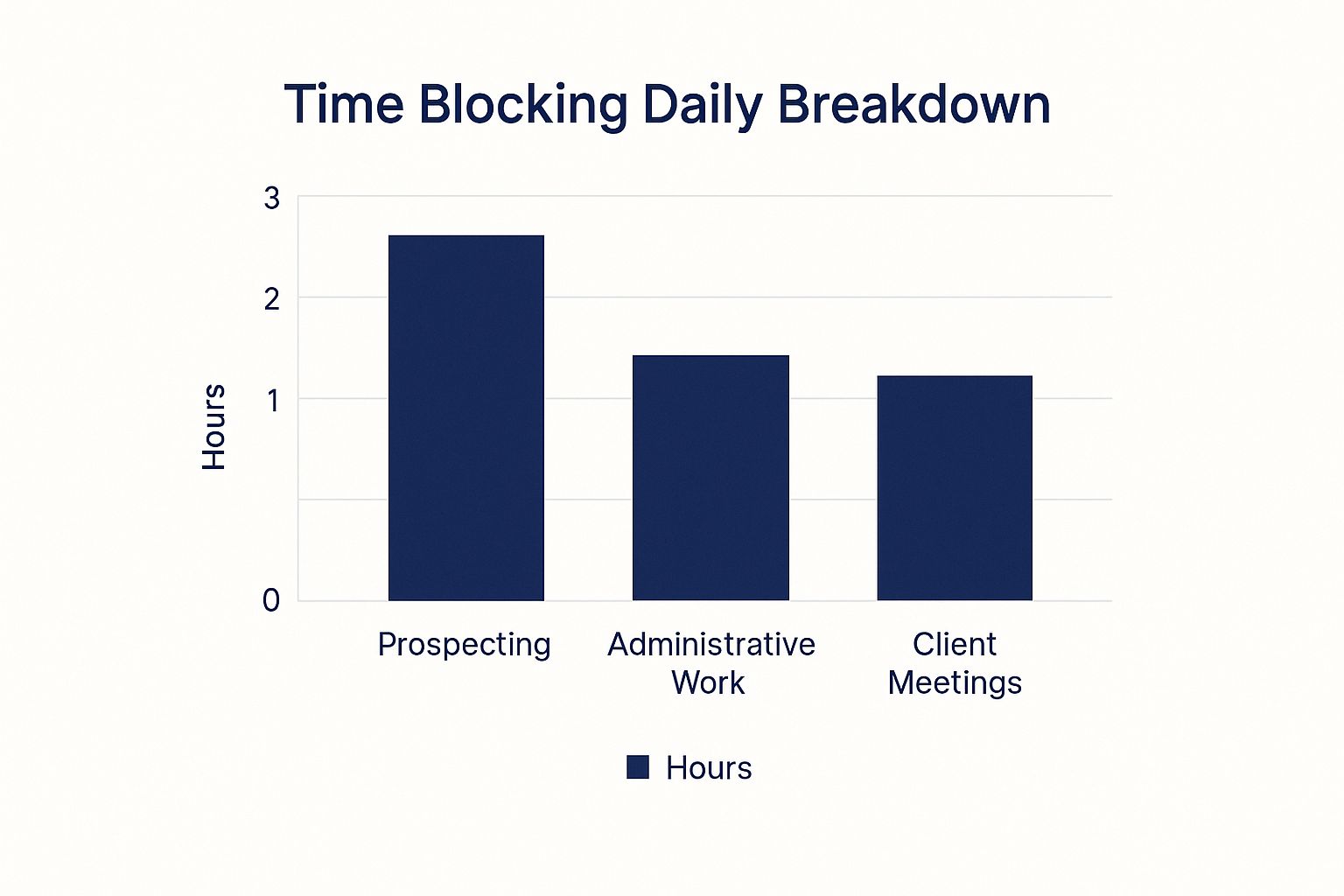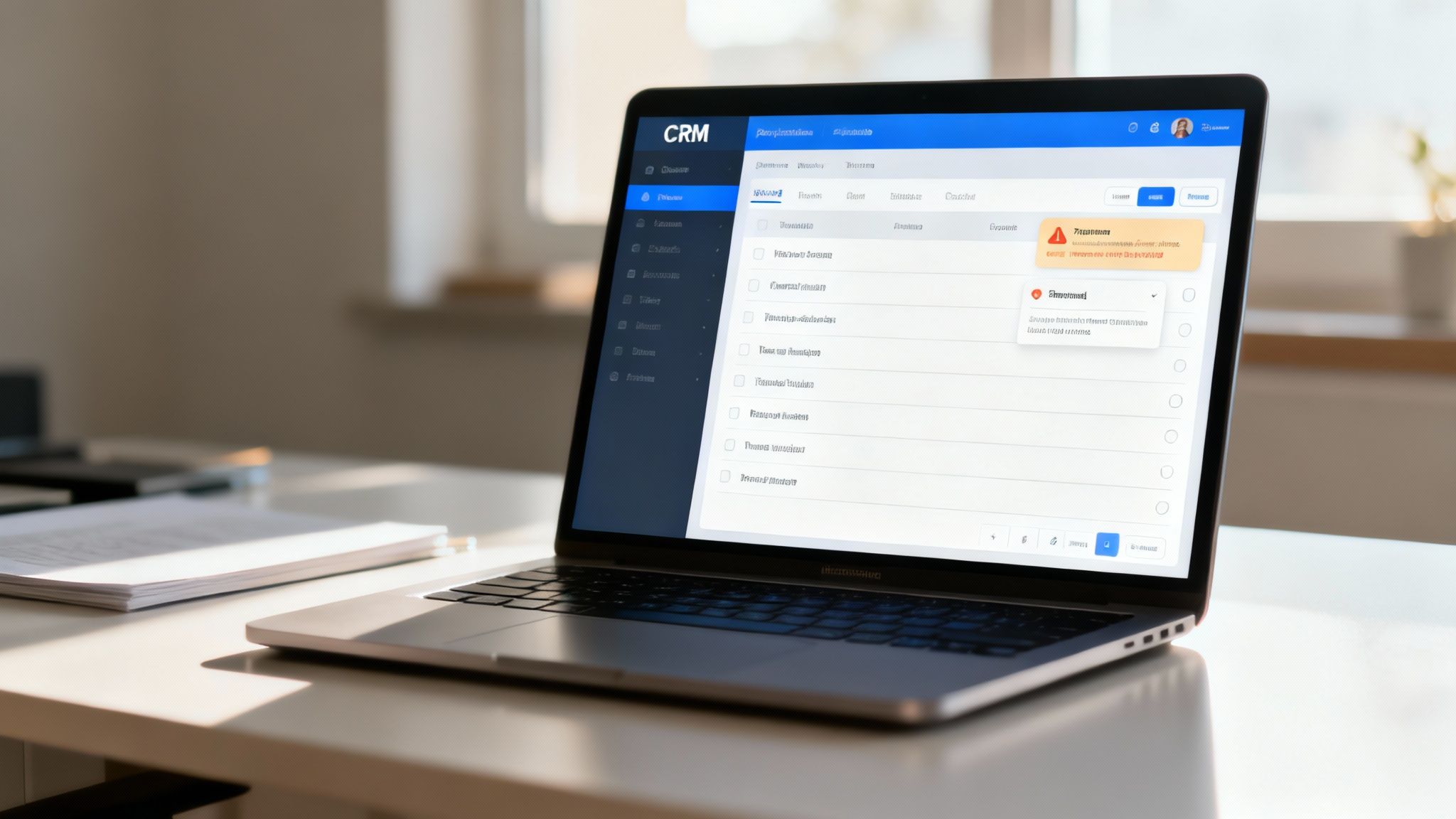Competitive Analysis SWOT A Guide to Outsmarting Rivals
Unlock your strategic edge with a competitive analysis SWOT. Learn to analyze rivals' strengths and weaknesses to find your unique market advantage.
Supercharge your productivity with these 8 actionable sales rep time management strategies. Learn to prioritize, automate, and close more deals. Read now!
TL;DR: Stop letting your calendar control you. Top sales reps reclaim nearly a third of their day by mastering simple time management techniques like time blocking and the 80/20 rule. These strategies help you focus on high-value activities that actually close deals, not just fill your schedule.
In sales, time isn't just money—it's quota. Every hour spent on low-value tasks is an hour not spent closing deals. Shockingly, the average sales rep dedicates less than 30% of their day to actual revenue-generating activities. The rest gets lost in a vortex of administrative work, endless research, and internal meetings. The difference between a good rep and a great one often boils down to one critical skill: effective sales rep time management. It’s not about working more hours; it’s about working smarter on the things that actually move the needle and drive commissions.
This guide cuts through the fluff to give you eight proven, actionable strategies that top performers use to reclaim their days, focus their efforts, and consistently crush their targets. Mastering these techniques is essential for any sales professional looking to gain a competitive edge. To truly take control and maximize output, sales reps can benefit from understanding effective time management strategies for a more stress-free workday. Ready to transform your calendar from a reactive mess into a strategic weapon? Let's dive in.
Time blocking is a powerful sales rep time management technique where you schedule your entire day into specific, dedicated time slots for each task. Instead of reacting to whatever comes up, you proactively assign every minute of your workday to a specific activity, such as prospecting, follow-ups, or administrative duties. This method, championed by productivity experts like Cal Newport, eliminates the guesswork from your day and combats the inefficiencies of multitasking.
The core principle is simple: treat your tasks as appointments. By dedicating a non-negotiable block of time to a single activity, you create an environment for deep, focused work. For instance, many successful sales organizations, like Grant Cardone's, implement strict morning blocks (e.g., 8 AM to 12 PM) exclusively for outbound prospecting, ensuring this high-value activity is always prioritized.
Getting started with time blocking is straightforward and can be customized to your peak performance hours and specific sales cycle demands.
The bar chart below illustrates a sample daily breakdown for a sales rep using this method, allocating specific hours to the most critical sales functions.

This visual breakdown demonstrates how a structured schedule ensures revenue-generating activities like prospecting receive the most significant time investment. By consistently protecting these blocks, reps build a predictable and productive routine that drives results.
The 80/20 Rule, or Pareto Principle, is a cornerstone of effective sales rep time management. It posits that roughly 80% of your results will come from just 20% of your efforts. For sales reps, this means a small fraction of your prospects, clients, and activities will generate the vast majority of your revenue. Instead of treating all tasks and leads as equal, you must identify and focus on this critical 20%.
The principle, popularized in business by authors like Richard Koch, forces a strategic shift from being busy to being productive. For example, Oracle sales teams famously restructured their qualification process after discovering that 15% of their prospects generated 82% of closed deals. This is the 80/20 rule in action: maximizing ROI by ruthlessly prioritizing high-impact areas and minimizing time spent on low-value tasks.
Applying this principle requires a data-driven approach to understand where your most valuable opportunities lie. It's about working smarter, not harder, by focusing your energy where it counts the most.
By systematically applying the 80/20 rule, sales reps can dramatically increase their efficiency. This ensures their limited time is consistently invested in the leads and activities that have the greatest potential to drive revenue and crush quotas.
A "Morning Power Hour" is a non-negotiable, dedicated block of time at the start of each day focused exclusively on high-value prospecting activities. This sales rep time management strategy involves committing the first 60 to 90 minutes of your workday to outbound tasks like cold calling, social selling, or email outreach before any other distractions, such as emails or internal meetings, can derail your focus. This approach, championed by sales leaders like Jeb Blount, capitalizes on peak morning energy and ensures consistent pipeline generation.
The core principle is to protect your most valuable revenue-generating activity from the reactive chaos of a typical day. By front-loading prospecting, you guarantee it gets done, creating momentum that carries you through the rest of your tasks. Steli Efti, CEO of Close CRM, famously built his sales culture around mandatory morning prospecting blocks, proving the model's effectiveness in driving predictable growth. This disciplined practice is foundational to successful B2B prospecting.

Setting up your Power Hour requires discipline and preparation to maximize its impact and turn it into a high-performance habit.
CRM-driven task management is a cornerstone of effective sales rep time management, transforming your Customer Relationship Management (CRM) system into the central hub for all sales activities. Instead of juggling scattered to-do lists, sticky notes, and calendar reminders, this method centralizes every customer interaction, next step, and deadline within your CRM. The system then acts as your personal assistant, automatically generating prioritized daily task lists based on deal stages, follow-up dates, and account value.
This approach ensures nothing falls through the cracks and keeps reps focused on the highest-impact activities. For example, HubSpot's task queue feature presents reps with a prioritized daily list based on deal probability, while Salesforce's Einstein Activity Capture automatically logs emails and suggests follow-up tasks. This discipline is crucial; one B2B software company reduced its missed follow-ups by an incredible 73% simply by mandating that all next steps be logged and managed within their CRM. To maximize efficiency, integrating your task management with robust CRM and meeting management features can provide a powerful advantage.

Adopting a CRM-first mindset requires discipline but pays significant dividends in productivity and organization. It aligns daily actions directly with pipeline goals.
By leveraging your CRM as a dynamic to-do list, you create a systematic and repeatable process for managing your pipeline, ensuring you consistently focus your efforts on the deals most likely to close.
Activity batching is a highly effective sales rep time management strategy where you group similar tasks together and execute them in dedicated, uninterrupted blocks. Instead of context-switching between making a call, writing an email, and updating the CRM, you handle all calls in one session, all emails in another, and all CRM updates together. This approach, popularized by thought leaders like Tim Ferriss, minimizes the mental fatigue associated with task-switching and creates a powerful rhythm.
The core principle is to reduce "cognitive switching costs," the mental energy and time lost when shifting between different types of tasks. By focusing on one activity type, such as LinkedIn outreach, you can enter a state of deep focus, or "flow," which dramatically increases both the speed and quality of your work. For instance, many inside sales teams batch all of their cold outreach into focused 30-minute sessions each day, allowing them to connect with dozens of prospects efficiently.
Integrating batching into your daily routine is simple and immediately boosts productivity by creating structure around repetitive tasks.
The bar chart below illustrates how a sales rep could structure their week by batching key activities on specific days, leading to a more organized and predictable workflow.
This visual shows how batching creates a focused weekly schedule, ensuring that distinct, high-impact activities receive dedicated attention without the constant distraction of multitasking. This method streamlines your workflow and builds momentum throughout the day.
The Two-Minute Rule is a simple yet powerful sales rep time management principle popularized by productivity consultant David Allen in his book "Getting Things Done." The rule is straightforward: if a task takes less than two minutes to complete, do it immediately instead of deferring it. For sales reps juggling countless small requests, this prevents micro-tasks from accumulating into an overwhelming administrative backlog.
Adopting this mindset helps maintain momentum and reduces the mental clutter of tracking numerous tiny commitments. Instead of letting small items like confirming a meeting or logging a basic call note linger, you handle them instantly, freeing up cognitive space for high-value selling activities. It’s a proactive approach to prevent small administrative tasks from derailing your focus on major pipeline-building efforts.
Integrating this rule into your daily workflow requires discipline and an accurate sense of time, but the payoff in efficiency is significant.
Weekly planning and daily prioritization is a powerful two-tiered sales rep time management system. This method involves dedicating 30-60 minutes each week to set major goals and then spending 10-15 minutes each morning to identify the top 3-5 tasks for that specific day. This approach, championed by thought leaders like Stephen Covey and Brian Tracy, balances long-term strategic direction with the tactical agility needed in a dynamic sales environment.
The weekly session ensures your efforts align with broader quota and pipeline goals, while the daily huddle maintains sharp, immediate focus. For example, enterprise sales reps use weekly planning to identify which 5-7 strategic accounts deserve dedicated focus, preventing their time from being diluted across less valuable opportunities. This dual-horizon planning prevents reps from getting lost in daily urgencies and losing sight of their most important objectives.
Integrating this system creates a proactive rhythm that drives consistent performance and reduces the stress of a purely reactive workday.
By adopting this structured yet flexible planning habit, sales reps can ensure their daily actions consistently contribute to their most significant long-term goals. It's a proven method to connect high-level strategy with day-to-day execution.
Eliminating time thieves is a crucial sales rep time management strategy focused on identifying and removing activities that consume valuable time without contributing to revenue. Popularized by authors like Tim Ferriss and Greg McKeown, this approach involves proactively auditing your day to pinpoint and eradicate interruptions, low-value tasks, and wasteful habits that derail productivity.
The core principle is to treat your time as your most valuable asset. By setting firm boundaries, you protect your most productive hours for high-impact selling activities. For example, some top-performing sales teams have implemented "Meeting-Free Mornings," a policy that reserves the first half of the day exclusively for outbound prospecting. This simple boundary has been shown to increase outbound activity by over 35% by shielding reps from internal distractions.
Getting started involves a conscious effort to identify wasteful activities and establish clear rules for how you allocate your time. This method empowers you to take control of your schedule rather than letting it control you.
This proactive approach to managing your schedule is a core component of strong operational efficiency. To learn more about how to streamline these processes across your entire revenue team, you can explore some RevOps best practices. By systematically removing low-value tasks and setting firm boundaries, you reclaim hours for what matters most: closing deals.
| Method | Implementation Complexity | Resource Requirements | Expected Outcomes | Ideal Use Cases | Key Advantages |
|---|---|---|---|---|---|
| Time Blocking for Sales Activities | Moderate - requires initial analysis & discipline | Calendar tools, scheduling software | Improved focus, protected selling time | Structured daily sales routines, time management | Reduces decision fatigue, minimizes context switching, enforces accountability |
| The 80/20 Rule for Lead Prioritization | High - needs data analysis and CRM discipline | CRM system, data analytics | Higher ROI per hour, focused selling | Prioritizing high-value leads and activities | Maximizes revenue by focusing on top 20% activities/clients |
| Morning Power Hour for Prospecting | Low to moderate - requires daily commitment | Quiet workspace, prepared prospect list | Consistent pipeline generation | Early-day outbound prospecting | Harnesses peak mental energy, builds momentum, prevents procrastination |
| CRM-Driven Task Management | High - requires CRM setup, training, and upkeep | CRM software, integration with calendars | Better follow-up, task prioritization | Managing complex pipelines, multi-touch follow-ups | Automates task management, improves visibility, reduces missed opportunities |
| Batching Similar Activities | Moderate - needs planning and discipline | Task-specific templates/tools | Increased efficiency and focus | Repetitive tasks like calls, emails, CRM updates | Minimizes context switching, builds flow state, improves task quality |
| The Two-Minute Rule for Immediate Tasks | Low - simple rule implementation | Awareness and time estimation skills | Reduced backlog, quicker responsiveness | Handling small, quick CRM and communication tasks | Prevents task accumulation, maintains momentum, reduces mental clutter |
| Weekly Planning and Daily Prioritization | Moderate - requires regular scheduling habit | Calendar, task list or planner | Balanced strategic/tactical focus | Goal setting, managing quota and priorities | Ensures alignment with goals, reduces decision fatigue, increases accountability |
| Eliminating Time Thieves and Setting Boundaries | Moderate to high - needs behavior changes and protocols | Time tracking tools, automation, communication guidelines | More available selling time, less stress | Reducing distractions and low-value activities | Increases focus and selling time, improves work-life balance, models professionalism |
Mastering sales rep time management isn't about finding a single magic bullet; it's about building a personalized system that protects your most valuable asset: your focus. Throughout this guide, we've explored eight powerful, actionable strategies designed to help you regain control of your calendar and drive meaningful results.
From the disciplined structure of time blocking to the ruthless prioritization of the 80/20 rule, each tactic offers a distinct way to optimize your workflow. Whether you're dedicating a "power hour" to prospecting, batching administrative tasks, or using your CRM to automate task management, the core principle remains the same. You must be intentional about where your time and energy go.
The journey to exceptional sales rep time management is built on consistency, not perfection. Instead of trying to implement all eight strategies at once, choose one or two that address your biggest challenges.
Ultimately, effective time management is a competitive advantage. It directly translates into more qualified pipeline, deeper client relationships, and, most importantly, more closed deals. The less time you spend on manual, repetitive work, the more time you can invest in the strategic, revenue-generating activities that define top performers.
This is where intelligent automation becomes a game-changer. By combining disciplined habits with powerful technology, you create a scalable system for success. When you offload the hours spent on pre-call research and data analysis, you free up critical time to do what you do best: connect with buyers and solve their problems. Effective sales rep time management empowers you to not just meet your quota but to consistently exceed it, transforming your potential into performance.
Ready to reclaim hours of research time every week and focus on closing deals? Salesmotion uses AI to automate prospect research and deliver actionable insights directly into your workflow, so you can spend less time preparing and more time selling. Learn how Salesmotion can transform your sales process.
1. What is the single most important time management skill for a sales rep?
Prioritization. The ability to distinguish high-value, revenue-generating activities (like prospecting and demos) from low-value tasks (like excessive admin work) is critical. Techniques like the 80/20 Rule are essential for focusing your limited time where it will have the biggest impact on your quota.
2. How can I stay disciplined with my time blocking schedule?
Treat your time blocks like client appointments—they are non-negotiable. Start small with just one or two protected blocks, like a "Morning Power Hour" for prospecting. Turn off notifications during these times and communicate your schedule to your team to minimize interruptions and build the habit.
3. What role does a CRM play in sales rep time management?
A well-used CRM is your central command for time management. It should automate task creation, prioritize your daily activities, and keep track of all follow-ups so nothing slips through the cracks. The goal is to let the CRM manage your to-do list so you can focus on executing.
4. How much time should a sales rep spend on prospecting?
While it varies by role, top performers often dedicate 20-30% of their time (or 8-12 hours per week) exclusively to prospecting. This ensures a consistently full pipeline. Using strategies like time blocking and a "Morning Power Hour" helps protect this crucial activity from other demands.
Unlock your strategic edge with a competitive analysis SWOT. Learn to analyze rivals' strengths and weaknesses to find your unique market advantage.
Discover how smart lead routing can stop revenue leaks and boost conversions. Learn proven strategies to automate and optimize your sales process.
A practical guide to the B2B sales funnel. Learn to build, measure, and optimize your funnel with proven strategies for converting leads into...